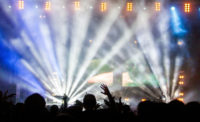Concerts have the power to draw thousands under one roof, packing arenas and stadiums with fervent fans hoping to immerse themselves in the power of experience. However, this same scene, if not properly managed, can also quickly lead to public safety and venue security risks.
For those who haven’t attended a concert in a while, the task of ensuring fan safety in the typical major venue has become a high-tech affair — beyond metal detectors at arena gates and deploying security personnel across the grounds. On its own, even strategic video cameras installation falls short of current security and safety expectations unless those surveillance systems are paired with more sophisticated and AI-driven analytics technologies to amplify the impact of security personnel, practices and resources.
The responsibility of protecting performers, staff and visitors demands additional layers of advanced planning and real-time responsiveness driven by intelligent video solutions. Here are a few ways existing surveillance investments can be enhanced with video analytics to increase public safety — without degrading the visionary visitor experience:
Crowd management: Drawing real-time, actionable intelligence from video data, video surveillance analytics can help security personnel monitor crowd movement and behavior in and around a venue before, during and after a game. Rather than devoting staff to monitoring video from dozens of cameras, venues can rely on video analytics to proactively detect signs of overcrowding and alert stadium staff to take necessary actions to prevent accidents and injuries.
Detecting offenders: The capabilities of human-driven surveillance go only so far. But modern authentication software has the ability to accurately identify individuals by their facial features, even from a distance or in the case of partial exposure from masks, etc. If a venue’s facial matching technology spots a person included on a specific watchlist, video analytics can alert security personnel, track the individual across cameras and help ensure they are removed from the venue quickly, every time.
Emergency response: AI-powered video analytics can be used to locate specific visitors — including lost children or other at-risk individuals — based on clothing or specific classifications. In the case of a potential abduction, video analytics can comb through surveillance footage almost instantly to narrow down video containing, for instance, a woman wearing a red jacket. In these emergency scenarios, video analytics can help locate an individual, provide real-time information to first responders, reduce response times and potentially save lives.
Video analytics at concert venues can’t replace security personnel. Security operators are critical to the management and maintenance of these advanced technologies and carry out all face-to-face interactions, warnings or removals. But video analytics help enhance the capabilities and scope of human operators, ultimately increasing fan safety. In addition, video analytics deliver valuable insights into fan behavior. This data can help venue management enhance security measures and develop advanced planning that reduce or eliminate risks. By using these technologies, concert venues can proactively monitor and manage potential threats and ensure a safer, more enjoyable experience for every fan.
This article originally ran in Security, a twice-monthly security-focused eNewsletter for security end users, brought to you by Security magazine. Subscribe here.




